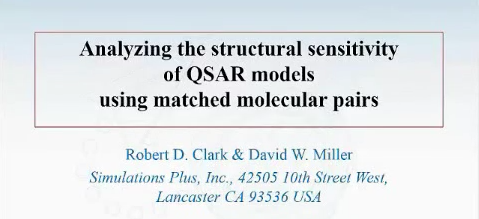This video explores analyzing the structural sensitivity of QSAR models using matched molecular pairs using MedChem Studio™

Modeling and Simulation to Support Clinical Development of Eslicarbazepine Acetate in Partial-Onset Epilepsy
Eslicarbazepine acetate (ESL) is a once-daily (QD) oral antiepileptic drug (AED) approved by the US Food and Drug Administration for the treatment of partial-onset seizures (POS) as monotherapy or…

Preclinical pharmacokinetic studies of 3-deazaneplanocin A, a potent epigenetic anticancer agent, and its human pharmacokinetic prediction using GastroPlus™
DZNep is a potential epigenetic drug, and exerts potent anti-proliferative and pro-apoptotic effects on broad-spectrum carcinomas via disruption of the EZH2 pathway.

Application of physiologically based pharmacokinetic modeling in the prediction of pharmacokinetics of bicyclol controlled-release formulation in human
Physiologically based pharmacokinetic (PBPK) modeling can assist in formulation development.

1,4-Oxazine beta-secretase (BACE1) inhibitors: from hit generation to orally bioavailable brain penetrant leads
Alzheimer’s disease (AD) is a progressive neurodegenerative disorder and the major cause of dementia in the elderly.

FDA’s Office of New Drug Products Places Order for 50 Additional Licenses to GastroPlus™
Additional Licenses Required to Meet Increasing Number of Submissions Utilizing GastroPlus

Regulatory Considerations for Approval of Generic Inhalation Drug Products in the US, EU, Brazil, China, and India
This article describes regulatory approaches for approval of "generic" orally inhaled drug products (OIDPs) in the United States, European Union, Brazil, China and India.

Simulations Plus Reports Preliminary Revenues for Fourth Quarter and Fiscal Year 2015
Company Reports Record Fourth-Quarter and Full-Year Revenues

Simulations Plus Awarded New Cooperative Agreement with FDA
Project to Support Enhancements to Company’s Industry-Leading GastroPlus™ Software

Deciphering nifedipine in vivo delivery from modified release dosage forms: Identification of food effect
With the increased reliance on in vitro dissolution testing as an indicator of in vivo drug behavior and the trend towards the in silico modeling of dosage form performance, the need for bioperformance...

Prospective Predictions of Human Pharmacokinetics for Eighteen Compounds
Quantitative predictions of pharmacokinetics (PKs) and concentration-time profiles using in vitro and in vivo preclinical data are critical to estimate systemic exposures for first-in-human studies.

Application of Absorption Modeling in Rational Design of Drug Product Under Quality-by-Design Paradigm
Physiologically based absorption models can be an important tool in understanding product performance and hence implementation of Quality by Design (QbD) in drug product development.

Application of Physiologically Based Absorption Modeling for Amphetamine Salts Drug Products in Generic Drug Evaluation
Amphetamine (AMP) salts-based extended-release (ER) drug products are widely used for the treatment of attention deficit hyperactivity disorder.

Discovery of new acetylcholinesterase inhibitors with small core structures through shape-based virtual screening
Targeting acetylcholinesterase (AChE) using small molecule inhibitors is considered to be the most successful therapeutic strategy in the treatment of Alzheimer’s disease (AD).

Prediction of pH dependent absorption using in vitro, in silico, and in vivo rat models: Early liability assessment during lead optimization
Weakly basic compounds which have pH dependent solubility are liable to exhibit pH dependent absorption. In some cases, a subtle change in gastric pH can significantly modulate the plasma concentration of...

In vitro dissolution methodology, mini-Gastrointestinal Simulator (mGIS), predicts better in vivo dissolution of a weak base drug, dasatinib
USP apparatus I and II are gold standard methodologies for determining the in vitro dissolution profiles of test drugs.

Intestinal solubility and absorption of poorly water soluble compounds: predictions, challenges and solutions
We have explored for which type of compounds biorelevant dissolution profiling in simulated intestinal fluids would accurately predict solubility in human intestinal fluid.

Development of a Physiologically Based Pharmacokinetic / Pharmacodynamic Model to Identify Mechanisms Contributing to Entacapone Low Bioavailability
Entacapone is an inhibitor of catechol-O-methyltransferase (COMT) and is being used to extend the therapeutic effect of levodopa in patients with advanced and fluctuating Parkinson's disease.

QSAR studies and design of new analogs of vitamin E with enhanced antiproliferative activity on MCF-7 breast cancer cells
Vitamin E is group of natural antioxidants comprised of tocopherols and tocotrienols.

